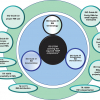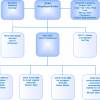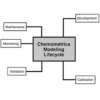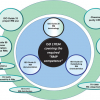Peter Jenks
The Jenks Partnership, Newhaven House, Junction Road, Alderbury, Salisbury, Wiltshire SP5 3AZ, UK
In recent months I have seen a growing use of the term “primary standard” by producers of certified reference materials. This intrigued me, and I looked further and the result of my research shows that there seems to be a degree of ignorance and confusion about the use of the term. So what is a primary reference material or standard, how does it differ from a certified reference material and which organisations are entitled to issue primary standards?
The widely accepted definition of a CRM is the one issued by ISO REMCO, thus:
A Certified Reference Material is a Reference Material, accompanied by a certificate, one or more of whose property values are certified by a procedure which establishes traceability to an accurate realisation of the unit in which the property values are expressed, and for which each certified value is accompanied by an uncertainty at a stated level of confidence.
What about the definition of a primary standard?
The primary source for all definitions metrological is the VIM, or International Vocabulary of Metrology—Basic and General Concepts and Associated terms, published by the BIPM or International Bureau of Weights and Measures and now in its third edition. The work to compile this important reference source was done by the International Standard Organisations’ Technical Advisory Group 4 (TAG 4) in the run up to the publication of “VIM 3” in 2012.
So what does VIM have to say on the matter?
VIM defines a primary measurement standard as a measurement standard established using a primary reference measurement procedure, or created as an artifact, as chosen by convention. The words primary measurement procedure are key, as will be made clear later.
VIM goes on to define a secondary measurement standard as a measurement standard established through calibration with respect to a primary measurement standard for a quantity of the same kind.
It is noted that calibration may be obtained directly between a primary measurement standard and a secondary measurement standard, or involve an intermediate measuring system calibrated by the primary measurement standard and assigning a measurement result to the secondary measurement standard.
ISO Guide 30 contains two very clear references:
Primary Standard: A standard that is designated or widely acknowledged as having the highest metrological qualities and whose value is accepted without reference to other standards of the same quantity, within a specified context.
Secondary Standard: A standard whose value is assigned by comparison with a primary standard of the same quantity.
The following terms are commonly used in both technical and commercial literature and advertising:
- Primary reference material
- Secondary reference materials
- In-house or working reference material
The first two may be described as certified reference materials but the difference between a primary and secondary is the point to which it is traceable and the level of uncertainty associated with the assigned value and the legal status of the producer. Indeed the vast majority of commercially produced CRMs and many NMI-produced CRMs fall into the secondary standard category since the certification of property values is usually carried out by a procedure traceable to primary standards.
Primary standards have the lowest possible uncertainty associated with the certified value. They also show traceability directly to the SI, as the reference material hierarchy table makes clear (Table 1).
Table 1. Reference material hierarchy table.
Measurement method | Traceability | Status |
Primary method | SI | Primary CRM |
Method of known bias | SI/International standard | Primary & secondary CRM |
Independent method(s) | Results of specified methods | Secondary CRM |
Inter-laboratory comparison | Results of specified methods | QCRM |
Because the definitions of a primary standard and a certified reference material do not make a clear reference to each other, a degree of creativity seems to be used by some suppliers, with CRMs that are clearly not primary standards being described as such.
How has this ambiguous use of the word “primary” developed?
Accreditation to ISO/IEC 17025 plus ISO Guide 34 allows an accredited producer to produce certified reference materials. But as is clear in the VIM definitions and in the table, CRMs may not be primary standards whilst all primary standards must also be CRMs.
One explanation given to me is that if there is no true primary standard for a specific measurement standard, then an accredited CRM producer producing a CRM to the best possible level of uncertainty and showing traceability to the SI by some means may call the product a primary standard. This is clearly incorrect, unless, of course, the producer is able to show direct (not indirect) traceability to the SI. Unfortunately the accreditation bodies auditing some CRM producers do not seem to pay as much attention to the accuracy and correctness of the certificates of authority (CoAs) and other documentation prepared by the CRM producer as they do to the analytical data used to develop the CoAs.
What has driven this behaviour? Over the last five years or so the number of “accredited producers” has grown and so CRMs from accredited producers now are in widespread use. This use has been driven by demand from the ever growing number of ISO/IEC Accredited testing laboratories: they need CRMs for method validation, equipment validation and QC. So demand has grown rapidly and as a result the supply of such materials has become big business!
To meet this demand, many of the network of 70 or more established specialist producers of reference materials have sought and obtained accreditation to ISO/IEC 17025 plus ISO Guide 34. The activity has attracted the attention of multi-nationals such as LGC Standards, Waters-ERA and Sigma Aldrich, all of which now play an important role as both producers and distributors of CRMs and related standards. There has also been consolidation in the market with acquisition of a number of the original specialists by the large players, the latest being the takeover of Dr Ehrenstorfer GmbH by LGC Standards.
Big business brings professional marketing and publicity and in some cases it seems that the people generating such material do not fully understand the subtle, but important nuances in the meaning of words.
Where does this leave the customer? Despite all the efforts of those that accredit commercial CRM producers not all CRMs appear to be the same and some producers use imprecise words to try and give the impression that the CRMs they offer are of a higher metrological standing than they really are. This is all rather sad as the CRMs offered are all produced to the “Gold Standard” and perfectly fit for purpose, they do not need dressing up like this.
Who is to blame? Whilst the marketing people produce the material and the accreditation bodies review it neither are completely to blame. The rapid expansion of the CRM “market” has left many of the definitions and the committees responsible for them behind with the result that the sort of ambiguity I’ve highlighted here can also be found with other definitions. There is an urgent need for the various committees, especially ISO REMCO and ISO TAG 4, to sit down and TOGETHER produce a SINGLE set of clear, unambiguous definitions written in plain English.
Unfortunately until these changes are made and the accreditation bodies ensure the definitions are properly used the marketing people will take advantage of the situation. So for now it does mean that users still have to read all literature and documents carefully. Unless there is a clear and direct traceability to the SI and there a very low uncertainty value associated with the assigned value, the product is not a primary standard even though it may well be a perfectly usable CRM.










